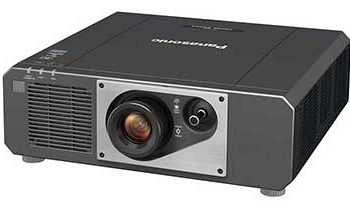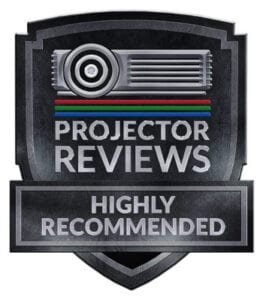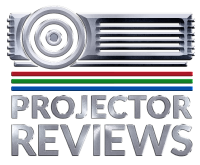Mitsubishi HC8000 Projector: 2D to 3D conversion
Like many other 3D capable projectors, this Mitsubishi is capable of taking a 2D signal and converting it to 3D. If anything, Mitsubishi spends a lot of ink touting how superior their 2D to 3D processing is.
So far, I'm still not a fan of 2D to 3D conversion. I figure it's a lot of fun with personal videos, but, in general too often you notice weird things when converting 2D content to 3D. An example: A street light in the background, where the pole seems to be on this side of the street, but the light across the street. Like the HC7900DW, the HC8000D seems particularly good converting 2D to 3D. I say that, but sooner or later I see something that "doesn't work". Perhaps if the lower brightness and having to wear the glasses, weren't required, I'd have a more positive opinion of 2D to 3D conversion. That said, this Mitsubishi is about as good as I've seen. (Not that I've really devoted any significant effort to really comparing how the different projector brands do on 2D to 3D conversion).
As I said about the HC7900D, if you want to do 2D to 3D, this HC8000D should be one of the better ones.
After I wrote the paragraphs above, I decided last night to put on the first Sherlock Holmes movie with Robert Downey Jr., and watch it using 2D to 3D conversion. There are plenty of times that it really does an excellent job of converting 2D to 3D, but there were a number of scenes that still didn't look right. In particular, there are several scenes showing a meeting of British Parliament, I believe, with a couple hundred people packed into a room and at varying elevations, so lots of small heads and bodies. Bam! The second I saw that scene, my brain yells, that's not believable. You sort of get the feeling heads are just slightly detached from some of the bodies, and the vertical heights in the room seem slightly distorted. In another scene, one closeup of the female lead (her name eludes me), her hair in the back seems too far behind her head... These aren't "I can't watch this" severe problems, but they sure aren't "right". Let's just say Mitsubishi's done a pretty good job, but they are a long, long, long way from the industry saying: "we don't have to shoot in 3D to get 3D, we'll just let smart projectors (and the smaller displays) handle the conversion."
HC8000D Creative Frame Interpolation - CFI - smooth motion
Like many other 3D capable projectors, this Mitsubishi is capable of taking a 2D signal and converting it to 3D. If anything, Mitsubishi spends a lot of ink touting how superior their 2D to 3D processing is.
So far, I'm still not a fan of 2D to 3D conversi
To make things interesting, this Mitsubishi, when creating intermediate frames from 24 fps content (movies), creates 4 frames between each two. That takes it to 120 hz, instead of the usual 96 hz. Mitsubishi claims that their CFI maintains the "film like" feel while providing smooth motion.
That said, as with most home theater projectors we review, I'm not a big fan of CFI on for movie viewing. This Mitsubishi's CFI may be pretty good, but not good enough to still seem film natural. I personally wouldn't use it for movies. Your call!
That said, it's true that many folks including my college age daughter, don't pay attention to such details, and will watch content with CFI on or off. My daughter can tell you if CFI is on or off rather effortlessly, but she normally just doesn't care if it's on or off when she's watching. Perhaps she will become more "selective" in the future. In other words - you (as the person "most into" home theater) are the most critical viewer in your familiy, so you too, may be less likely to engage CFI on any projector when watching film-based movies. In this day and age, most newer LCDTVs that I observe in people's homes have CFI, (figure most of those that claim 120hz or higher) and in most cases, it seems they default to on. As I visit friends, I usually notice that they have CFI engaged. Of course until I tell most of them, they have no idea.
Time to move on. Let's look at the HC8000D's hardware.
on. I figure it's a lot of fun with personal videos, but, in general too often you notice weird things when converting 2D content to 3D. An example: A street light in the background, where the pole seems to be on this side of the street, but the light across the street. Like the HC7900DW, the HC8000D seems particularly good converting 2D to 3D. I say that, but sooner or later I see something that "doesn't work". Perhaps if the lower brightness and having to wear the glasses, weren't required, I'd have a more positive opinion of 2D to 3D conversion. That said, this Mitsubishi is about as good as I've seen. (Not that I've really devoted any significant effort to really comparing how the different projector brands do on 2D to 3D conversion).
As I said about the HC7900D, if you want to do 2D to 3D, this HC8000D should be one of the better ones.
After I wrote the paragraphs above, I decided last night to put on the first Sherlock Holmes movie with Robert Downey Jr., and watch it using 2D to 3D conversion. There are plenty of times that it really does an excellent job of converting 2D to 3D, but there were a number of scenes that still didn't look right. In particular, there are several scenes showing a meeting of British Parliament, I believe, with a couple hundred people packed into a room and at varying elevations, so lots of small heads and bodies. Bam! The second I saw that scene, my brain yells, that's not believable. You sort of get the feeling heads are just slightly detached from some of the bodies, and the vertical heights in the room seem slightly distorted. In another scene, one closeup of the female lead (her name eludes me), her hair in the back seems too far behind her head... These aren't "I can't watch this" severe problems, but they sure aren't "right". Let's just say Mitsubishi's done a pretty good job, but they are a long, long, long way from the industry saying: "we don't have to shoot in 3D to get 3D, we'll just let smart projectors (and the smaller displays) handle the conversion."



